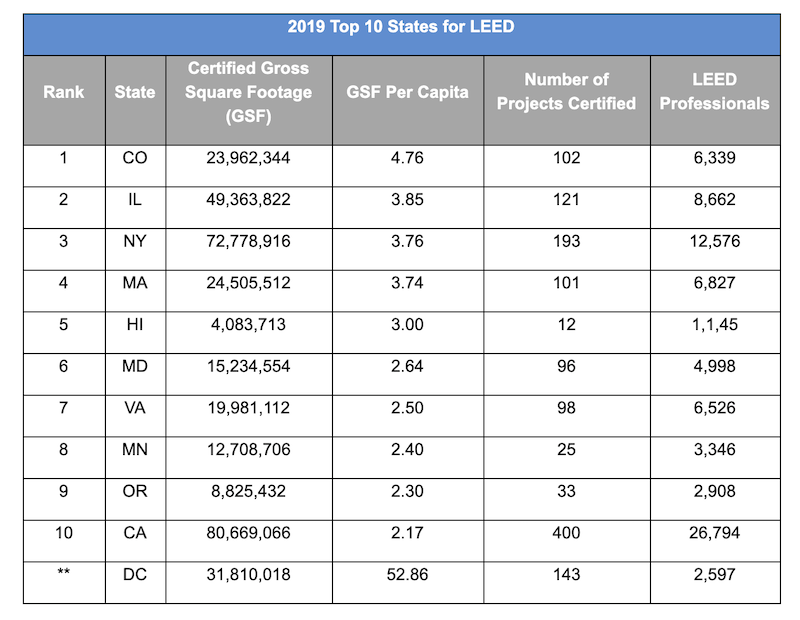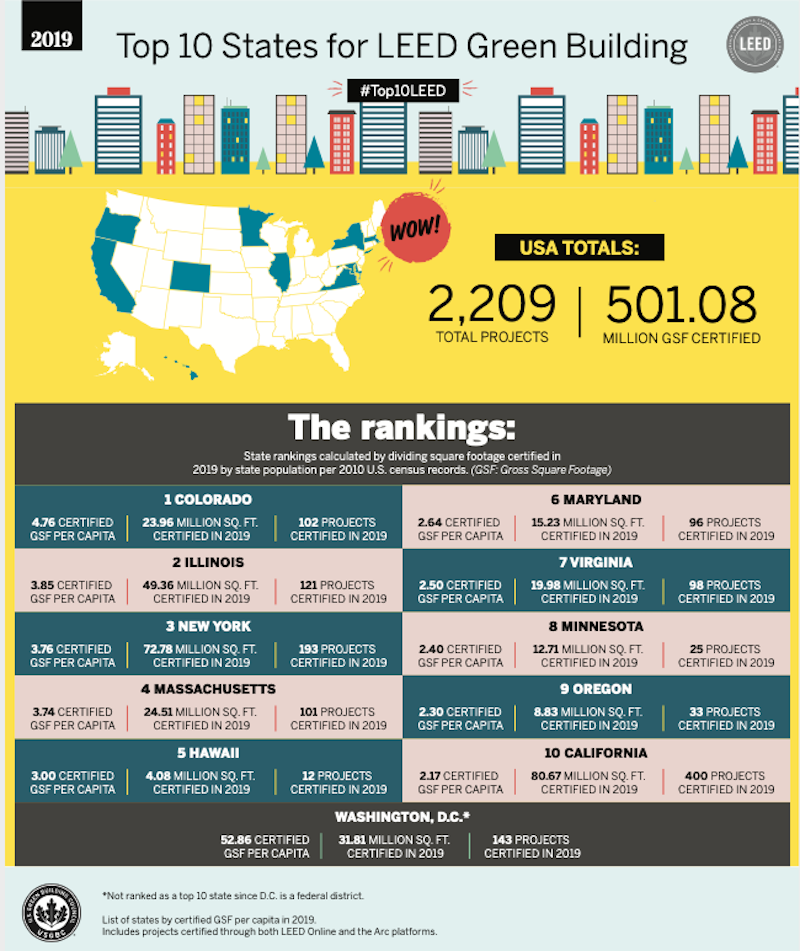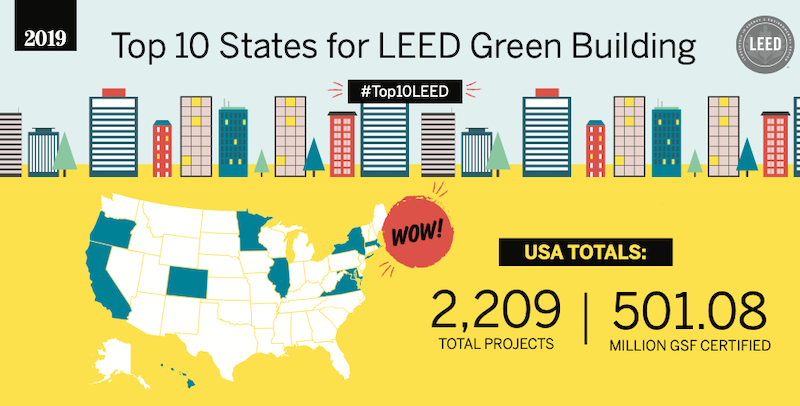As cities and states continue to work toward climate action goals, the U.S. Green Building Council (USGBC) has announced its list of Top 10 States for LEED green building. For the first time since 2011, Colorado took the top spot on the list, which ranks states based on the number of LEED certified square feet per person. LEED, or Leadership in Energy and Environmental Design, is the most widely used green building rating system in the world with more than 100,000 projects engaged. This year’s top states are home to more than 105 million people, including more than 80,000 LEED green building professionals with the skills to support the sustainable transformation of buildings.
“As we embark on a new decade, the USGBC community is focused on helping more projects get on the path to LEED certification and a more sustainable future,” said Mahesh Ramanujam, president and CEO, USGBC. “Over the last year, the Top 10 states have certified projects that serve as incredible examples of how green building can create more sustainable and resilient spaces that improve our living standard. There is still much work to be done, but the progress made across these states shows us that our work is having a tangible impact on people’s lives. As we enter our next chapter, we are committed to helping more buildings, cities and communities improve their sustainability performance through LEED.”
LEED-certified projects support personal health and well-being, as well as use less energy and water, reduce carbon emissions and save money for families, businesses and taxpayers. The Top 10 list is based on 2010 U.S. Census data and includes commercial and institutional green building projects certified throughout 2019. Colorado certified 102 green building projects representing 4.76 square feet of LEED-certified space per resident. The state has made the Top 10 list each year but jumped to the top spot after ranking sixth in 2018. Minnesota and Oregon reemerged as Top 10 states after missing the list last year, coming in at number eight and nine respectively. The full rankings are as follows:

USGBC calculates the list using per capita figures to allow for a fair comparison of the level of green building taking place among states with significant differences in population and number of overall buildings. Despite Washington, D.C. not appearing in the official Top 10 list because of its status as a federal territory, it consistently leads the nation and in 2019 certified 52.86 square feet of space per resident across 143 green building projects. The nation’s capital has a strong legacy of sustainability leadership and has expanded its use of LEED from buildings to cities and communities to support its goals. In 2017, it became the first LEED-certified city and in 2019 certified the Golden Triangle Business Improvement District LEED Platinum, the first business improvement district in the world to certify.
With green building expected to grow globally through 2021, the need for skilled professionals to support green building projects has never been more important. Across the U.S. there are more than 165,000 LEED green building professionals with the knowledge to help cities and communities transition to greener buildings and spaces. LEED professionals demonstrate a competency in green building principles that can set projects on the path to certification and help them consider ways to reduce their impact on the environment and provide people with healthier, more sustainable spaces to live, learn, work and play.

As USGBC continues to advance green buildings, cities and communities through the adoption of LEED and the latest version of the rating system, LEED v4.1, the organization is also considering a future that is focused on a more regenerative approach. In November 2019 at the annual Greenbuild International Conference & Expo, USGBC introduced LEED Positive – a roadmap that will lay the foundation for a future of LEED that transitions away from strategies that only reduce harm and instead focus on those that help repair and restore. With a continued focus on performance, USGBC is laying the groundwork to ensure sustainable design, construction and operations of buildings, cities and communities remains focused on better buildings that contribute to better lives.
Related Stories
Market Data | Feb 2, 2022
Majority of metro areas added construction jobs in 2021
Soaring job openings indicate that labor shortages are only getting worse.
Market Data | Feb 2, 2022
Construction spending increased in December for the month and the year
Nonresidential and public construction lagged residential sector.
Market Data | Jan 31, 2022
Canada's hotel construction pipeline ends 2021 with 262 projects and 35,325 rooms
At the close of 2021, projects under construction stand at 62 projects/8,100 rooms.
Market Data | Jan 27, 2022
Record high counts for franchise companies in the early planning stage at the end of Q4'21
Through year-end 2021, Marriott, Hilton, and IHG branded hotels represented 585 new hotel openings with 73,415 rooms.
Market Data | Jan 27, 2022
Dallas leads as the top market by project count in the U.S. hotel construction pipeline at year-end 2021
The market with the greatest number of projects already in the ground, at the end of the fourth quarter, is New York with 90 projects/14,513 rooms.
Market Data | Jan 26, 2022
2022 construction forecast: Healthcare, retail, industrial sectors to lead ‘healthy rebound’ for nonresidential construction
A panel of construction industry economists forecasts 5.4 percent growth for the nonresidential building sector in 2022, and a 6.1 percent bump in 2023.
Market Data | Jan 24, 2022
U.S. hotel construction pipeline stands at 4,814 projects/581,953 rooms at year-end 2021
Projects scheduled to start construction in the next 12 months stand at 1,821 projects/210,890 rooms at the end of the fourth quarter.
Market Data | Jan 19, 2022
Architecture firms end 2021 on a strong note
December’s Architectural Billings Index (ABI) score of 52.0 was an increase from 51.0 in November.
Market Data | Jan 13, 2022
Materials prices soar 20% in 2021 despite moderating in December
Most contractors in association survey list costs as top concern in 2022.
Market Data | Jan 12, 2022
Construction firms forsee growing demand for most types of projects
Seventy-four percent of firms plan to hire in 2022 despite supply-chain and labor challenges.

















